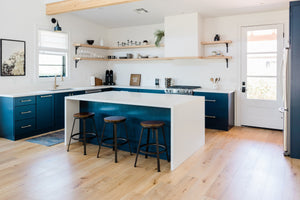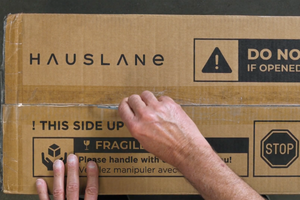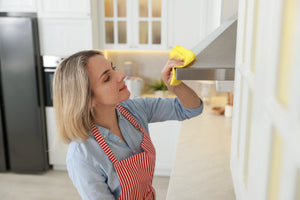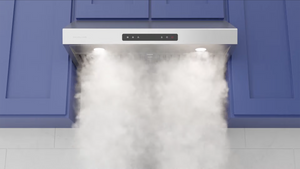Kitchen Design Over the Past 100 Years
Have you ever wondered how the American kitchen transitioned from those orange countertops you see in Brady Bunch reruns to the sleek stainless steel appliances and modern minimalism of today?
Kitchen design has gone through a massive transformation over the years, so we thought it would be fun to take you through its evolution—not just going back 50 years, but a full century!
We’ll go decade by decade, starting with the 1920s, with illustrations showing the gradual changes taking place in each era. You’ll spot small changes in each decade, and you’ll see how each change adds up to create a radically new interior design style over the long haul.
At Hauslane, we’re just as passionate about the kitchen as you and other home chefs are. We hope you’ll have as much fun reading this as we did writing it.


(Photo credit: Underwood Archives)
1920s Early Modern Kitchen
The “modern” kitchen was born in the 1920s, when new technologies like electricity and running water became part of its design. Of course, not every kitchen had these luxuries, but people still made it work.
The style itself feels quaint and a little bland to our generation, with subdued color schemes—black, white, gray, and sometimes a little green, as you see in the illustration. The 1920s kitchen emphasized function and utility over aesthetics. It was largely a workspace, rather than the heart of the home, so you didn’t see many dining tables.
It just wasn’t a place to socialize back then because kitchens were smaller and designed for work. The socialization took place in the dining room instead.

(Photo credit: FPG)
1930s Kitchen: A Dash of Color and Style
The 1930s kitchen became slightly more inviting, introducing new color schemes and tables where family members could eat breakfast and connect. New colors worked their way into the mix, such as pale blue cabinets and beige countertops.
By the mid-1930s, 70% of the United States had access to electricity, which is why you now see an electric refrigerator and modern lighting in the example. The gas stove no longer has giant pipes coming through the wall, but you still won’t see range hoods in most homes for a while.
Range hoods were invented in the 1930s, but they didn’t become widespread until the 50s and 60s, leaving families vulnerable to the dangers of cooking exhaust.
Of course, if you traveled back in time to warn them about indoor air pollution, they’d think you were crazy and take another drag of their cigarette.

(Photo credit: Underwood Archives)
1940s Kitchen: Getting Brighter
The 1940s saw more incremental changes, although it’s not a huge leap from the 1930s kitchen. As the Great Depression eased up, you find more homes with access to comforts that became available to a select few in the 1930s.
Still, this remained a time of austerity. The world was in the midst of the Second World War throughout half the decade, and rationing meant preserving food—expressed in the popular slogan: “Dig for Victory.”
Nevertheless, there are some incremental changes in style during the 40s that will burst into full bloom in the 50s. You’ll notice more colors, a wider array of kitchen gadgets, and more cupboard space.
There were still no range hoods to keep indoor air clean, but that just wasn’t a priority. In fact, they had ads in the 1940s that touted Camel Cigarettes as the brand rated #1 by doctors across America.

(Photo credit: Ethan - Flickr)
1950s Kitchen: A Burst of Color and Change
Happy days are here again, and the 1950s kitchen is a testament to optimism, new styles, and the embrace of technology.
What seems retro and maybe a little gaudy to us felt futuristic to them. You’ll find bright pastels that remind you of a candy shop, with laminate countertops featuring iconic Formica boomerang patterns. All this symbolized middle-class prosperity.
We may prefer the more antique feel of past eras, but the 1950s kitchen was the bridge between the past and the present, introducing metal sinks, larger spaces to enjoy company, and modern appliances like electric blenders, electric stoves, and (finally, range hoods.)

(Photo credit: Ethan - Flickr)
1960s Kitchen: Warm and Open
There are decades of radical change, and there are periods of gradual evolution. The 1960s kitchen represents a small shift from the 1950s, embracing more warmth in design and more openness in its layout.
In fact, this is when the open-plan kitchen began to take hold, featuring more space to socialize and warmer colors—toning down the candy shop feel of the 1950s. Wood cabinetry starts to take hold in the mid-60s, and it will really take off in the 70s.
This is where you start to see a rise in earth tones like avocado green and pumpkin orange, although the orange won’t really take hold until the next decade. A nice mix of color and social functionality, the 1960s kitchen set the stage for the wild leap that we’ll see as we dive into the groovy 70s.

(Photo credit: @andthentheotherone - Instagram)
The 1970s Kitchen: Bold and Earthy
The radical social change of the late 1960s, and the Baby Boomers’ coming of age, saw a corresponding shift toward a very different interior design style in the 1970s.
Kitchens of the 70s combine unique colors like mustard yellow, chocolate brown, and that characteristic pumpkin orange with earth tones. Wood cabinets were all the rage, giving kitchens a cozy, den-like feel. Open layouts connect family rooms and dining rooms to the kitchen. You also see the rise of wallpaper, which often featured bright, colorful patterns.
When it comes to kitchen appliances, the 70s produced an array of kitchen gadgets, from toasters to fondue pots. We didn’t pack the illustration with those gadgets because the average homeowner would have tucked them away, but it was an era of experimentation.
Curious to see some weird and wonderful retro kitchen gadgets? Click the link to see things like a hand-cranked apple peeler from 1903, a 1940s egg scale, and the 1960s Veg-O-Matic with its iconic tagline: “It slices, it dices!”

The 1980s Kitchen: Toned Down Styles + New Tech
The 1970s were a wild time for fashion and interior design, but eventually those bell-bottoms and bright colors gave way to a more conservative style.
Wallpaper remained popular, but the patterns were simpler and not nearly as bold as the 70s style. Natural wood cabinets continued into the decade, with a refined appearance. The trend toward open-plan layouts, which began in the 60s, continued into the 80s. Today, they’re common in most suburban homes.
Where the 80s took a real leap forward was in the realm of technology. Self-cleaning ovens became popular, dishwashers got quieter, toaster ovens replaced the classic steel toaster, and microwaves became a staple in American homes by the mid-80s.

(Photo credit: ML Harris)
The 90s Kitchen: A Transitional Period
It may be hard to distinguish the 90s kitchen from the 80s, but you’ll notice subtle changes that set the stage for some major shifts at the turn of the millennium.
The 90s saw a return to simplicity and natural materials. Shaker-style cabinets became popular, and muted color schemes took hold. There was also a trend toward “hidden” appliances. For example, notice the way the refrigerator is perfectly tucked into the cabinetry. People also hid trash cans in cabinets to reduce clutter.
Kitchen appliances made major leaps in energy efficiency, as more Americans grew concerned about their environmental impact. In 1992, the Environmental Protection Agency (EPA) introduced the Energy Star program, using the Energy Star label to demonstrate that an appliance meets certain efficiency standards.

(Photo credit: Getty Images)
The 2000s Kitchen: Next-Level Openness
In the 2000s, the kitchen truly became an everything space, reaching the next level of open design. With space to move around, socialize, cook, eat, do homework, and entertain, we’re finally starting to see something that resembles today’s kitchens.
Notice the rise of stainless steel appliances. This will continue to grow in the coming decades. Its sleek, stylish appeal somehow feels both futuristic and classic to our generation. Of course, who knows how homeowners will see it 100 years from now?
You also see the rise of kitchen islands, granite countertops, and stylish maple and cherry wood cabinets. Appliances continue to become more advanced and energy efficient to adhere to stricter standards, and quality and durability improve.

(Photo credit: Parade of Homes Showcase Home - Brighton Homes)
The 2010 Kitchen: Sleek and Bright + Smart Technology
The 2010s saw even more interesting design trends, with many homeowners shifting back to white and beige as dominant colors. White shaker cabinets, marble and quartz countertops, and muted colors made those stainless steel appliances stand out even more.
Of course, that’s just one end of the spectrum. Other homeowners embraced two-tone cabinets (e.g., navy blue or forest green lower cabinets with white upper cabinets), bold brass handles, and vintage appliances.
Why such a contrast between design styles? One theory is that the decade saw the rise of social media, where influencers made home design available to everyone. Just as this era saw a burgeoning of different musical niches through Spotify and unique TV shows on cable TV, homeowners embraced a range of different styles.
Speaking of those influencers, we’ve written a blog post about our favorite YouTuber kitchen designers and DIYers. Check it out for inspiration!
Appliance technology made even greater leaps during this period, where we saw the rise of smart, Wi-Fi-connected refrigerators, voice-activated lighting, and coffee makers you could program from your phone.

Today’s Kitchen: Smart, Sustainable, and Stylish
The 2020s aren’t over yet, and it’s hard to say how things will evolve. That said, we’ve already seen some powerful trends take hold in recent years, creating an even greater leap than previous decades.
Just as we saw in the 2010s, a range of styles have continued to develop, but there’s a major trend toward openness, black faucets (and sometimes black stainless steel appliances), and light colors (e.g., white and beige with natural wood tones).
Cabinets often no longer have handles, and homeowners use their ample cabinet space for storage, creating a clean, minimalist look. Smart, energy-efficient technology continues to advance, with smooth induction cooktops that are flush with the countertop for easier cleaning.
We’re also seeing some interesting trends, such as indoor hydroponic herb gardens, where home chefs can create their own farm-to-table experience. Combined with natural wood tones, these herb gardens exemplify the idea of the living kitchen.
Thinking of Upgrading Your Kitchen? Start with the Range Hood.
If you’re planning to upgrade your kitchen or replace old appliances, the range hood is a great place to start.
You can get a high-quality, affordable range hood from Hauslane that exceeds energy standards, keeps your family safe from indoor air pollution, and looks great—incorporating the latest design styles like durable, chic stainless steel.
Powerful Kitchen Ventilation
From HAUSLANE








